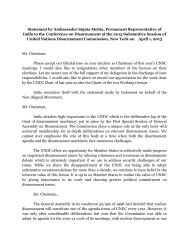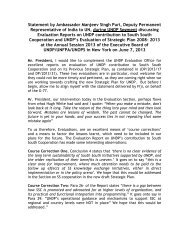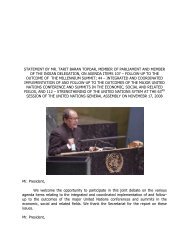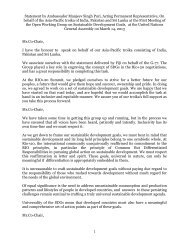STATE OF THE WORLD'S CITIES 2012/2013 Prosperity
STATE OF THE WORLD'S CITIES 2012/2013 Prosperity
STATE OF THE WORLD'S CITIES 2012/2013 Prosperity
You also want an ePaper? Increase the reach of your titles
YUMPU automatically turns print PDFs into web optimized ePapers that Google loves.
urban poor, particularly in slums and squatter settlements.<br />
Deficient infrastructure can drive up the costs of doing<br />
business in urban areas and reduce firm productivity by<br />
as much as 40 per cent30 , and its impact can be as large<br />
as those of crime, bureaucracy, corruption or financial<br />
market constraints. 31 Deficient infrastructure is also a<br />
major impediment to trade and competitiveness in many<br />
developing countries, particularly landlocked and small<br />
island states. In the case of Africa, the proportion of paved<br />
roads in is about five times less than in high income OECD<br />
countries; the end-result of this infrastructure bottleneck<br />
is that transport costs are 63% higher in African countries<br />
compared with developed countries. 32 This has major<br />
implications for competitiveness of African cities on local<br />
and international markets.<br />
High incidence of slums and poverty<br />
Slums feature the most deplorable living and environmental<br />
conditions and are characterized by inadequate water<br />
supply, poor sanitation, overcrowded and dilapidated<br />
housing, hazardous locations, insecurity of tenure and<br />
vulnerability to serious health risks – all of which have<br />
major implications for quality of life. Slums are also known<br />
for their atmosphere of fear and the social and economic<br />
exclusion of their residents. 33 Slum dwellers are often<br />
Figure 3.1.2<br />
Perceived impediments to the prosperity of cities<br />
per cent of respondents<br />
45<br />
40<br />
35<br />
30<br />
25<br />
20<br />
15<br />
10<br />
5<br />
0<br />
99<br />
From Comparative Advantage to Urban <strong>Prosperity</strong><br />
stigmatized on account of<br />
Cities with large<br />
their location and are often<br />
proportions of their<br />
discriminated against in<br />
populations living in slum<br />
conditions are less likely to<br />
terms of access to public<br />
be prosperous.<br />
and social services, as well<br />
as employment.<br />
Slum prevalence<br />
is highest in Sub-Saharan Africa (62 per cent), where<br />
basic services are lacking not only in informal, but<br />
formal settlements, too. North Africa features the lowest<br />
prevalence (13 per cent). In Asia, the average proportion<br />
of urban populations living in slums ranges from 25 per<br />
cent in Western Asia to 35 per cent in South Asia. In Latin<br />
America and the Caribbean, average slum prevalence is<br />
24 per cent. To a large extent, regional patterns of slum<br />
prevalence reflect degrees of access to basic services such<br />
as water and sanitation, as well as the nature of urban<br />
development policies.<br />
Poor governance & weak institutions Corruption Inadequate infrastructure<br />
High incidence of slums and poverty<br />
High levels of crime<br />
High cost of doing business Low levels of human capital<br />
Africa Asia LAC Arab States All regions<br />
Source: UN-Habitat City Monitoring Policy Survey, 2011<br />
FACT<br />
Inadequate infrastructure is a major impediment to the<br />
prosperity of cities. The impacts of deficient infrastructure<br />
appear to be more pronounced in Asian and African cities and less<br />
so in Arab States.<br />
FACT















![1 statement by dr.[mrs] kakoli ghosh dastidar - Member States Portal](https://img.yumpu.com/27526598/1/190x245/1-statement-by-drmrs-kakoli-ghosh-dastidar-member-states-portal.jpg?quality=85)

